Dawn: first in a Ceres
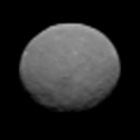 The unmanned NASA spacecraft Dawn transmits a series of pictures of Ceres, the minor planet which is the largest known object in the main asteroid belt between Mars and Jupiter, back to Earth, representing the best view yet of an object which had been seen as little more than a point of light since its discovery in 1801. From a distance of only 147,000 miles, Dawn is able to see more detail on Ceres than the best Hubble Space Telescope images of the same body. Dawn will arrive at Ceres and use its ion propulsion system to enter its orbit in March 2015.
The unmanned NASA spacecraft Dawn transmits a series of pictures of Ceres, the minor planet which is the largest known object in the main asteroid belt between Mars and Jupiter, back to Earth, representing the best view yet of an object which had been seen as little more than a point of light since its discovery in 1801. From a distance of only 147,000 miles, Dawn is able to see more detail on Ceres than the best Hubble Space Telescope images of the same body. Dawn will arrive at Ceres and use its ion propulsion system to enter its orbit in March 2015.

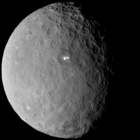 The unmanned NASA/JPL space probe Dawn arrives at its second and final destination, the dwarf planet Ceres, a body which dominates the asteroid belt between Mars and Jupiter. Beginning to bring itself into a closer mapping orbit around Ceres, Dawn has already spotted unusually bright surface features, drawing early speculation from scientists that the highly reflective points on Ceres may be indicative of ice formations or cryovolcanism. Though its main engine is powered by charged ions, Dawn is scheduled to remain at Ceres for as long as its chemical propellant supply holds, powering smaller traditional rockets needed for attitude control.
The unmanned NASA/JPL space probe Dawn arrives at its second and final destination, the dwarf planet Ceres, a body which dominates the asteroid belt between Mars and Jupiter. Beginning to bring itself into a closer mapping orbit around Ceres, Dawn has already spotted unusually bright surface features, drawing early speculation from scientists that the highly reflective points on Ceres may be indicative of ice formations or cryovolcanism. Though its main engine is powered by charged ions, Dawn is scheduled to remain at Ceres for as long as its chemical propellant supply holds, powering smaller traditional rockets needed for attitude control.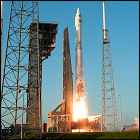 NASA launches the unmanned OSIRIS-REx (Origins Spectral Interpretation Resource Identification Security Regolith Explorer) spacecraft, bound for the asteroid Bennu, a target it won’t reach for two years. Once at Bennu, OSIRIS-REx is intended to orbit the asteroid and then drop down close enough to gather surface samples for return to Earth in a small sample container capable of surviving re-entry through the atmosphere. The samples from Bennu, an asteroid considered a hazard for Earth in the future, will not arrive until September 2023.
NASA launches the unmanned OSIRIS-REx (Origins Spectral Interpretation Resource Identification Security Regolith Explorer) spacecraft, bound for the asteroid Bennu, a target it won’t reach for two years. Once at Bennu, OSIRIS-REx is intended to orbit the asteroid and then drop down close enough to gather surface samples for return to Earth in a small sample container capable of surviving re-entry through the atmosphere. The samples from Bennu, an asteroid considered a hazard for Earth in the future, will not arrive until September 2023.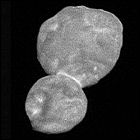 NASA’s New Horizons space probe, operated by Johns Hopkins University’s Applied Physics Lab, passes within 2,200 miles of the mysterious Kuiper Belt object 2014 MU69, a tiny fragment of leftover material from the birth of the solar system. Previously seen only as a tiny pixel even by the powerful lens of the Hubble Space Telescope, nothing was known of 2014 MU69 prior to the flyby, which revealed it as a contact binary: two bodies which had become gravitationally fused together. As 2014 MU69 (informally nicknamed Ultima Thule in a public poll conducted by the New Horizons public outreach team) is a billion miles further away than Pluto, and with New Horizons continuing outward at 30,000 miles per hour, signals between Earth and New Horizons take at least six hours to reach their destination, so the downlink of data from the flyby would take until 2020 to complete.
NASA’s New Horizons space probe, operated by Johns Hopkins University’s Applied Physics Lab, passes within 2,200 miles of the mysterious Kuiper Belt object 2014 MU69, a tiny fragment of leftover material from the birth of the solar system. Previously seen only as a tiny pixel even by the powerful lens of the Hubble Space Telescope, nothing was known of 2014 MU69 prior to the flyby, which revealed it as a contact binary: two bodies which had become gravitationally fused together. As 2014 MU69 (informally nicknamed Ultima Thule in a public poll conducted by the New Horizons public outreach team) is a billion miles further away than Pluto, and with New Horizons continuing outward at 30,000 miles per hour, signals between Earth and New Horizons take at least six hours to reach their destination, so the downlink of data from the flyby would take until 2020 to complete.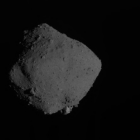 Japan’s Hayabusa-2 uncrewed spacecraft, carrying samples of material from asteroid 162173 Ryugu, begins its long trip home after spending nearly a year and a half in Ryugu’s orbit, where it deposited autonomous robotic landers and fired a projectile into Ryugu’s surface to loosen material for capture and return to Earth. First launched in 2014, Hayabusa-2’s return trajectory to Earth is expected to bring the samples of asteroid material home to a safe landing in Australia in late 2020.
Japan’s Hayabusa-2 uncrewed spacecraft, carrying samples of material from asteroid 162173 Ryugu, begins its long trip home after spending nearly a year and a half in Ryugu’s orbit, where it deposited autonomous robotic landers and fired a projectile into Ryugu’s surface to loosen material for capture and return to Earth. First launched in 2014, Hayabusa-2’s return trajectory to Earth is expected to bring the samples of asteroid material home to a safe landing in Australia in late 2020.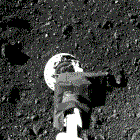 NASA’s OSIRIS-REx robotic spacecraft successfully gathers a generous sample of the surface regolith of asteroid 101955 Bennu on its first attempt, with some of the material estimated to originate from as deep as 49 centimeters beneath Bennu’s surface. (This result indicates that the asteroid’s surface is much softer and more pliable than expected.) The touchdown point was selected in conjunction with volunteer citizen scientists searching for safe places to gather a sample, and ruling out potential touchdown sites that appeared to be too hazardous. Intended to gather a minimum of 60 grams of material from Bennu, OSIRIS-REx is believed to have exceeded that minimum by a wide margin, and approval is given to stow the sample in its return container a week ahead of schedule. OSIRIS-REx will remain in Bennu’s orbit until March 2021, at which time it will fire its engines to begin its journey to return the samples of asteroid matter to Earth in September 2023.
NASA’s OSIRIS-REx robotic spacecraft successfully gathers a generous sample of the surface regolith of asteroid 101955 Bennu on its first attempt, with some of the material estimated to originate from as deep as 49 centimeters beneath Bennu’s surface. (This result indicates that the asteroid’s surface is much softer and more pliable than expected.) The touchdown point was selected in conjunction with volunteer citizen scientists searching for safe places to gather a sample, and ruling out potential touchdown sites that appeared to be too hazardous. Intended to gather a minimum of 60 grams of material from Bennu, OSIRIS-REx is believed to have exceeded that minimum by a wide margin, and approval is given to stow the sample in its return container a week ahead of schedule. OSIRIS-REx will remain in Bennu’s orbit until March 2021, at which time it will fire its engines to begin its journey to return the samples of asteroid matter to Earth in September 2023.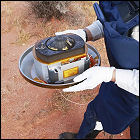 The Japanese space agency, JAXA, successfully recovers the Hayabusa-2 space probe’s sample return container after its return to Earth in Austrailia. The container’s precious cargo is 100 milligrams of surface and subsurface material retrieved by Hayabusa-2 from the surface of asteroid 162173 Ryugu during a series of touch-and-go maneuvers performed between February and July of 2019. Though it drops its samples off during a close flyby of Earth, Hayabusa-2 remains in space, where JAXA hopes to redirect it to study further asteroids, though the probe will no longer have the ability to gather or return samples.
The Japanese space agency, JAXA, successfully recovers the Hayabusa-2 space probe’s sample return container after its return to Earth in Austrailia. The container’s precious cargo is 100 milligrams of surface and subsurface material retrieved by Hayabusa-2 from the surface of asteroid 162173 Ryugu during a series of touch-and-go maneuvers performed between February and July of 2019. Though it drops its samples off during a close flyby of Earth, Hayabusa-2 remains in space, where JAXA hopes to redirect it to study further asteroids, though the probe will no longer have the ability to gather or return samples.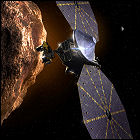 NASA launches the Lucy spacecraft on its twelve-year mission to study select specimens of the Trojan asteroid swarms that both precede and trail the planet Jupiter at the stable LaGrange points in its orbit. Lucy’s complex trajectory calls for it to conduct gravity assist flybys of Earth in 2022 and 2024, and to survey the main asteroid belt body 52246 Donaldjohanson in 2025, en route to reaching its first Trojan asteroid, 3548 Eurybates, in 2027. Future targets include 15094 Polymele later in 2027, 11351 Leucus and 21900 Orus in 2028, and – after a further gravity assist flyby of Earth in 2030 – the binary Trojan pair 617 Patroclus-Menoetius in 2033. Lucy’s name is not an abbreviation; it is named after a famous fossil skeleton discovered in 1971 by a team led by anthropologist David Johanson; it is hoped that studying the Trojan asteroids will lead to discoveries that make them similar “missing links” in the solar system’s own fossil record.
NASA launches the Lucy spacecraft on its twelve-year mission to study select specimens of the Trojan asteroid swarms that both precede and trail the planet Jupiter at the stable LaGrange points in its orbit. Lucy’s complex trajectory calls for it to conduct gravity assist flybys of Earth in 2022 and 2024, and to survey the main asteroid belt body 52246 Donaldjohanson in 2025, en route to reaching its first Trojan asteroid, 3548 Eurybates, in 2027. Future targets include 15094 Polymele later in 2027, 11351 Leucus and 21900 Orus in 2028, and – after a further gravity assist flyby of Earth in 2030 – the binary Trojan pair 617 Patroclus-Menoetius in 2033. Lucy’s name is not an abbreviation; it is named after a famous fossil skeleton discovered in 1971 by a team led by anthropologist David Johanson; it is hoped that studying the Trojan asteroids will lead to discoveries that make them similar “missing links” in the solar system’s own fossil record.